|

Huguenot Ancestor
Nicholas Martiau
PRINT Version
of this article
Link to
The National
Huguenot Society Back to


Lineage from
Nicholas Martiau
Nicholas
Martiau
m. Jane Berkeley
Elizabeth Martiau
m. George Reade
Mildred Reade
m. Augustine Warner
Elizabeth Warner
m. John Lewis II
Robert Lewis
m. Jane Meriwether
Nicholas Lewis
m. Mary Walker
Jane Meriwether Lewis
m. Hudson Martin
Mary Walker Martin
m. Thurston Dickinson
Frances Elizabeth Dickinson
m. John Duggins
Elizabeth Marshall Duggins
m. James Henry Smith
Laura Ann Smith
m. Peter Christian Jensen
Lucile Marguerite Jensen
m. Wilhelm A. Heineman
Peter E. Heineman
m. Doris
J. Crum
Peter L.
Heineman |
History of the Huguenots
|
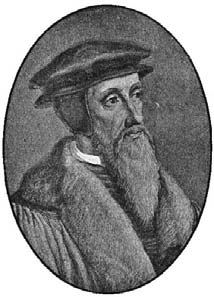
John Calvin |
The
Huguenots were
French Protestants who were members of the
Reformed Church which was established in 1550 by
John
Calvin.
Huguenot
predecessors included the pro-reform and
Gallican Roman Catholics, like
Jacques Lefevre. Later, Huguenots followed
the
Lutheran movement, and finally,
Calvinism.
They shared
John
Calvin's fierce
reformation beliefs which decried the
priesthood,
sacramental theology, and doctrines of the
Roman
Catholic Church.
They believed in
salvation as an act of God as much as in creation as an
act of God, and thus that only God's
predestined mercy toward the elect
made them fit for salvation. Some see this dual
emphasis on creation and on salvation, and God's
sovereignty over both, as a cornerstone principle for
Huguenot developments in architecture and textiles and
other merchandise. |
The origin of the name
Huguenot is uncertain, but dates from approximately 1550 when it
was used in court cases against "heretics" (dissenters from the
Roman Catholic Church). There is a theory that it is derived
from the personal name of Besançon Hugues, the leader of the
"Confederate Party" in Geneva,
in combination with a Frankish corruption of the German word for
conspirator or confederate: eidgenosse.
Thus, Hugues plus eidgenot becomes Huguenot,
with the intention of associating the Protestant cause with some
very unpopular politics.
O.I.A. Roche, in his
book The Days of the Upright, a History of the Huguenots,
writes that
"Huguenot" is
"a combination of a Flemish and a German word. In the Flemish
corner of France, Bible students who gathered in each other's
houses to study secretly were called Huisgenooten, or "house
fellows," while on the Swiss and German borders they were termed
Eidgenossen, or "oath fellows," that is, persons bound to each
other by an oath. Gallicized into "Huguenot," often used
deprecatingly, the word became, during two and a half centuries
of terror and triumph, a badge of enduring honor and courage."
As nickname and even
abusive name it's use was banned in the regulations of the Edict
of Nantes which Henry IV (Henry of Navarre, who himself
earlier was a Huguenot) issued in 1598. The French Protestants
themselves preferred to refer to themselves as "réformees"
(reformers) rather than "Huguenots".
Above all, Huguenots became
known for their fiery criticisms of worship as performed in the
Roman Catholic Church, in particular the focus on ritual and
what seemed an obsession with death and the dead. They believed
the ritual, images, saints,
pilgrimages,
prayers, and hierarchy of the
Catholic Church did not help anyone toward
redemption. They saw Christian
faith as something to be expressed in a strict and godly life,
in obedience to Biblical laws, out of gratitude for God's mercy.
Like other Protestants of
the time, they felt that the Roman church needed radical
cleansing of its impurities, and that the
Pope represented a worldly
kingdom, which sat in mocking tyranny over the things of God,
and was ultimately doomed. Rhetoric like this became more fierce
as events unfolded, and stirred up the hostility of the Catholic
establishment.
Violently opposed to the
Catholic Church, the Huguenots attacked images,
monasticism, and church
buildings. Most of the cities in which the Huguenots gained a
hold saw iconoclast attacks, in
which altars and images in churches, and sometimes the buildings
themselves were torn down. Bourges,
Montauban and
Orleans suffered particularly.
Huguenots faced periodic
persecution from the outset of the Reformation; but
Francis I (reigned 1515–1547)
initially protected them from
Parlementary measures
designed for their extermination. The
Affair of the Placards of 1534 changed the king's posture
toward the Huguenots: he stepped away from restraining
persecution of the movement.
Huguenot numbers grew
rapidly between 1555 and
1562, chiefly amongst the
nobles and city-dwellers. During this time, their opponents
first dubbed the Protestants Huguenots; but they called
themselves reformés, or "Reformed." They organized their
first national synod in 1558, in Paris.
By 1562, they had a total
membership estimated at least a million, especially numerous in
the southern and central parts of the country. The Huguenots in
France likely peaked in number at approximately two million,
compared to approximately sixteen million Catholics during the
same period.
In reaction to the growing
Huguenot influence, and the aforementioned instances of
Protestant zeal, Catholic violence against them grew, at the
same time that concessions and edicts of toleration became more
liberal.
In
1561, the
Edict of Orléans, for example,
declared an end to the persecution; and the
Edict of Saint-Germain
recognized them for the first time (January
17, 1562); but these
measures disguised the growing strain of relations between
Protestant and Catholic.
Tensions led to eight
civil wars, interrupted by
periods of relative calm, between 1562 and 1598. With each break
in peace, the Huguenots' trust in the Catholic throne
diminished, and the violence became more severe, and Protestant
demands became more grand, until a lasting cessation of open
hostility finally occurred in 1598.
The
wars gradually took on a dynastic character, developing into an
extended feud between the Houses of
Bourbon and Guise, both
of which — in addition to holding rival religious views — staked
a claim to the French throne. The crown, occupied by the House
of Valois, generally supported
the Catholic side, but on occasion switched over to the
Protestant cause when politically expedient.
Wars of Rebellion
The
French Wars of
Religion began with a massacre at
Wassy
on
March 1,
1562,
in which at least 30 (some sympathetic sources say 1000 or more)
Huguenots were killed, and about 200 were wounded.
|
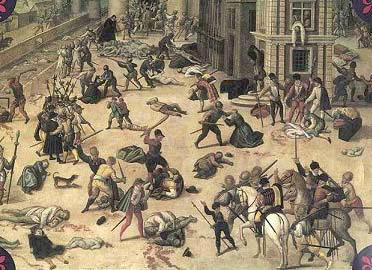
St. Batholomew massacre,
1572 |
The Huguenots transformed themselves into a definitive
political movement thereafter. Protestant preachers
rallied a considerable army and a formidable cavalry,
which came under the leadership of Admiral
Gaspard de Coligny.
Henry
of Navarre and the House of Bourbon allied
themselves to the Huguenots, adding wealth and holdings
to the Protestant strength, which at its height grew to
sixty fortified cities, and posed a serious threat to
the Catholic crown and Paris over the next three
decades.
In
what became known as the
St.
Bartholomew's Day Massacre of
24
August –
17
September
1572,
Catholics killed thousands of Huguenots in Paris.
Similar massacres took place in other towns in the weeks
following, with an estimated total death toll of
110,000. An amnesty granted in 1573 pardoned the
perpetrators.
|
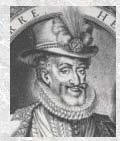
King Henry
IV |
It was
Catherine de Medici who persuaded her weakling son
Charles IX to order the mass murder, which lasted three
days and spread to the countryside. On Sunday morning
August 24th, 1572 she personally walked through the
streets of Paris to inspect the carnage.
Henry of
Navarre's life was spared when he pretended to support
the Roman Catholic faith. In 1593 he made his "perilous
leap"and abjured his faith in July 1593, and 5 years
later he was the undisputed monarch as King Henry IV (le
bon Henri, the good Henry) of France. |
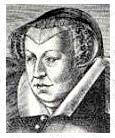
Catherine de
Medici |
When the first rumors of
the massacre reached the Vatican in Rome on 2 September 1572,
Pope Gregory XIII was jubilant and wanted bonfires to be lit in
Rome. He was persuaded to wait for the official communication.
The very morning of the day that he received the confirmed news,
the pope held a consistory and announced that "God had been
pleased to be merciful". Then with all the cardinals he
repaired to the Church of St. Mark for the Te Deum, and
prayed and ordered prayers that the Most Christian King might
rid and purge his entire kingdom (of France) of the Huguenot
plague.
On 8 September 1572 a
procession of thanksgiving took place in Rome, and the pope, in
a prayer after mass, thanked God for having "granted the
Catholic people a glorious triumph over a perfidious race" (gloriosam
de perfidis gentibus populo catholico loetitiam tribuisti).
Gregory XIII engaged
Vasari to paint scenes in one of the Vatican apartments of the
triumph of the Most Christian King over the Huguenots. He had a
medal struck representing an exterminating angel smiting the
Huguenots with his sword, the inscription reading:
Hugonottorium strages (Huguenot conspirators). In France
itself, the French magistracy ordered the admiral to be burned
in effigy and prayers and processions of thanksgiving on each
recurring 24th August, out of gratitude to God for the victory
over the Huguenots.
The
fifth
holy war
against the Huguenots began on
February 23,
1574.
The conflict continued periodically until
1598,
when Henry of Navarre, having converted to Catholicism and
become King of France as
Henry IV,
issued the
Edict of
Nantes. The Edict granted the Protestants equality
with Catholics under the throne and a degree of religious and
political freedom within their domains. The Edict simultaneously
protected Catholic interests by discouraging the founding of new
Protestant churches in the Catholic-controlled regions.
|
The Huguenots were allowed to
practice their faith in 20 specified French "free"
cities. France became united and a decade of peace
followed. After Henry IV was murdered in 1610, however,
the persecution of the "dissenters" resumed in all
earnestness under the guidance of Cardinal Richelieu,
whose favorite project was the extermination of the
Huguenots.
With the proclamation of the Edict of Nantes, and the
subsequent protection of Huguenot rights, pressures to
leave France abated, as did further attempts at
colonization. |
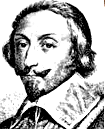
Cardinal
Richelieu |
|
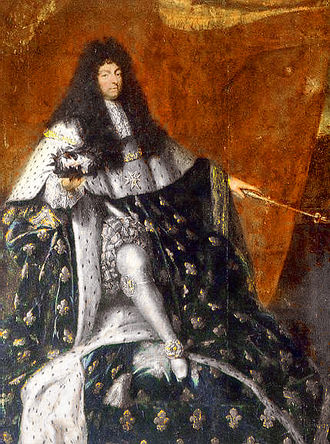
King Louis
XIV |
However,
Louis XIV
(the Sun King, 1643-1715) began to apply his
motto l'état c'est moi ("I am the state") and
introduced the infamous Dragonnades - the
billeting of dragoons in Huguenot households. He began
with a policy of une foi, un loi, un roi (one
faith, one law, one king) and revoked the Edict of
Nantes on 22 October 1685. The large scale persecution
of the Huguenots resumed.
Huge numbers of
Huguenots (with estimates ranging from 200,000 to
500,000) fled to surrounding Protestant countries:
England, the
Netherlands,
Switzerland,
Norway,
Denmark and
Prussia — whose Calvinist Great Elector
Frederick William welcomed them to help
rebuild his war-ravaged and under-populated country.
Protestant churches and the
houses of "obstinates" were burned and destroyed, and
their bibles and hymn books burned. Emigration was
declared illegal. Many Huguenots were burned at the
stake. Many Huguenots who did not find their death in
local prisons or execution on the wheel of torture, were
shipped to sea to serve their sentences as
galley
slaves, either on French galley ships, or
sold to Turkey as galley slaves. |
The first Huguenots to
leave France seeking freedom from prosecution had done so years
earlier under the leadership of
Jean Ribault
in
1562.
The group ended up establishing the small colony of
Fort Caroline
in
1564,
on the banks of the
St. Johns
River, in what is today
Jacksonville,
Florida.
The colony was the first
attempt at any permanent European settlement in the present-day
United States,
but the group survived only a short time. In September
1565,
an attack against the new Spanish colony at
St. Augustine
backfired, and the Spanish wiped out the
Fort Caroline
garrison.
Settlement in South Africa
On
December 31,
1687
a band of Huguenots set sail from France to the colony at the
Cape of Good
Hope,
South Africa.
Individual Huguenots settled at the Cape of Good Hope from as
early as 1671 and an organized, large scale emigration of
Huguenots to the Cape of Good Hope took place during 1688 and
1689. A notable example of this is the emigration of Huguenots
from
La Motte
d'Aigues in
La Provence,
France.
Many of these settlers
chose as their home an area called
Franschhoek,
Dutch
for French Corner, in the present day
Western Cape
province of South Africa. A large monument to commemorate the
arrival of the Huguenots in South Africa was inaugurated on 7
April 1948 at
Franschhoek.
Many of the farms in the
Western Cape province in South Africa still bear French names
and there are many families, today mostly
Afrikaans
speaking, whose surnames bear witness to their French Huguenot
ancestry. Examples of these are: Blignaut, Hugo,
Joubert,
du Toit,
de Villiers,
Viljoen,
Theron,
du Plessis,
Malan,
le Roux
and
Labuschagne
amongst others, which are all common surnames in present day
South Africa.
Settlement in North America
Barred from settling in
New France,
many Huguenots moved instead to the Dutch colony
New Netherland
later incorporated into New York and New Jersey and the
13 colonies
of Great Britain in
North America,
the first in
1624.
Huguenot immigrants founded
New Paltz, New
York, where is now located the oldest street in
America with the original stone houses,
New Rochelle,
New York (named after
La Rochelle
in France).
Chretien du
Bois was one of the original Huguenot settlers in
this area.
Some of the settlers chose
the
Virginia
Colony, and formed communities in present-day
Chesterfield
County and
Powhatan
County just west of
Richmond,
Virginia, where their descendants continue to reside.
The
Huguenot
Memorial Bridge across the
James River
was named in their honor, as were many local features including
several schools.
Many Huguenots also settled
in the area around the current site of
Charleston,
South Carolina. In 1685, Rev. Elie Prioleau from the
town of Pons in France settled in what was then called
Charlestown. He became pastor of the first Huguenot church in
North America in that city. The French Protestant (Huguenot)
Church of Charleston, which remains independent, is the oldest
continuously active Huguenot congregation in the United States
today.
Most of the Huguenot
congregations in North America merged or affiliated with other
Protestant denominations, such the
Presbyterian
Church (USA),
United Church
of Christ,
Reformed
Churches, and the
Reformed
Baptists.
Asylum in Britain
An estimated 50,000 Huguenots fled to
Britain. A leading Huguenot theologian and writer who led the
exiled community in London,
André Lortie
(or
Andrew Lortie),
became known for articulating Huguenot criticism of the
Holy See
and
transubstantiation.
Of these refugees, upon
landing on the Kent coast, many gravitated towards Canterbury,
then the county's hub, where many Huguenot families were granted
asylum.
Edward VI
granted them the whole of the crypt of
Canterbury
Cathedral for worship. This privilege later shrank to
the former
chantry
chapel of the
Black Prince,
where there is still a Huguenot chapel. Access can now be gained
to this chapel by those whose names are derived from any of the
French names featured on a poster on the chapel's outer door,
and it is also open to the general public on the annual
cathedral open-evening in October. Other evidence of the
Huguenots in Canterbury includes 'the Weavers', a half-timbered
house deriving its name from their chief occupation, and they
also settled elsewhere in Kent, particularly
Tenterden.
Huguenot refugees flocked
to
Shoreditch,
London
in large numbers. They established a major weaving industry in
and around
Spitalfields
(see
Petticoat Lane
and the
Tenterground),
and in
Wandsworth.
The
Old Truman
Brewery, then known as the Black Eagle Brewery,
appeared in
1724.
The fleeing of Huguenot refugees from
Tours,
France
had virtually wiped out the great
silk
mills they had built.
Many Huguenots settled in
Ireland during the
Plantations of
Ireland. Some of them fought against the troops of
Louis XIV
in the
Williamite war
in Ireland, for which they were rewarded with land
grants and titles. Some of them took their skills to
Ulster
and assisted in the founding of the Irish
linen
industry.
Asylum in Germany and Scandinavia
Huguenots refugees found a safe haven
in the Lutheran and Reformed countries in Germany and
Scandinavia. Nearly 44,000 Huguenots established in Germany.
Several congregations were founded, such as the Fredericia (Danmark),
Stokholm, Frankfurk, Emden, Middleburg.
The exodus of Huguenots
from France created a kind of
brain drain
from which the kingdom would not fully recover for years. The
French crown's refusal to allow Protestants to settle in New
France was a factor behind that colony's slow population growth,
which ultimately led to its conquest by the British. By the time
of the
French and
Indian War, there may have been more people of French
ancestry living in Britain's
American
colonies than there were in New France.
Frederick the
Great of
Prussia,
a strong believer in religious tolerance, invited Huguenots to
settle in his realms, and a number of their descendants rose to
positions of prominence in Prussia. The last Prime Minister of
the (East)
German
Democratic Republic,
Lothar de
Maizière, was a scion of a Huguenot family.
The persecution and flight
of the Huguenots greatly damaged the reputation of Louis XIV
abroad, particularly in England; the two kingdoms, which had
enjoyed peaceful relations prior to
1685,
became bitter enemies and fought against each other in a series
of wars from
1689
onward.
Persecution of Protestants
ended in 1764, and the
French
Revolution of 1789 finally made them full-fledged
citizens.
Protestants in France today
number about 1 million, or about 2% of the population. They are
most concentrated in the
Cévennes
region in the south.
The Huguenot Legacy
A third of
American
Presidents have some proven Huguenot
ancestry,
as do
Alexander
Hamilton,
John Jay,
and other leading statesmen, and (according to an oft-repeated
belief) one quarter or more of all Englishmen.
Huguenot refugees in
Prussia
are thought to have contributed significantly to the development
of the
textile
industry in that state.
In
1924
a commemorative half dollar, known as the
Huguenot-Walloon Half Dollar, was coined in the
United States
to celebrate the 300th anniversary of their initial settlement
in what is now the United States. One Huguenot colonist was a
silversmith named Apollos Rivoire, who would later anglicize his
name to
Paul Revere.
He would, still later, give his name and his profession to his
son,
Paul Revere,
the famous
United States
revolutionary.
A
neighborhood in
New York City's
borough of
Staten Island
is named
Huguenot,
and the nearby town of
New Rochelle
is named after
La Rochelle,
a former Huguenot stronghold in France.
Captain Nicholas
Martiau
Nicholas Martiau “Captain Nick”
was born in Il de Rhe France 1591. The Martiaus were French
Walloon Huguenots residing in the Valley of the Meuse, Belgium
Walloon refers, in daily
speech to French-speaking Belgians from Wallonia, “the land of
the valleys.” When the Religious War, known as the
Thirty years War commenced in 1619, fifty-five families,
including the Martiaus, fled for their lives and took refuge in
Holland. In the spring of the year 1620, some months before the
Mayflower sailed for America, Nicholas Martiau, of a family of
French Protestants sailed from England for America in the
vessel, the Francis Bona Venture. Martiau acquired and
settled upon a tract of land along the York River in Virginia.
Nicholas Martiau was in
the service of Henry Hastings, Earl of Huntington and member of
the Virginia Company, and educated as a military engineer. He
was naturalized as an Englishman by royal decree. He came to
Jamestown in 1620, legally representing the Earl to plan
fortifications.
After the 1622 massacre
at Jamestown, the depredations of the Indians had caused such
concern among the first settlers that a series of forts and
outposts were planned, and the first "western" frontier was
established by a line crossing the Tidewater Peninsula from
Jamestown to the Charles (York) river along which it was
proposed to erect a wall of logs. The construction of this log
palisade and the protective forts was entrusted to Martiau, and
the site on the Charles selected of a fort was called York.
Martiau's
defense of the French king in an argument with Capt. Thomas
Mayhew forced him to take a loyalty oath in Jamestown in 1627.
The fort at York
occupied a point on the river at the mouth of the Wormley Creek,
named for the first settler in that section, Colonel Christopher
Wormley, and lies about two miles down the river from the
present site of Yorktown. The safety of the fort caused a
settlement to spring up around it, and in 1633 York was selected
as a receiving port. A store was built for receiving and
shipping purposes, and to serve the inhabitants both of York and
the settlement at Kiskiack.
So sturdily did Martiau
build York for that it was still in active use more than forty
years later when it was described as "the most considerablest
fortress in the country." During the Indian uprisings along
the Rappahannock in 1676 the terror-stricken county folk of
Gloucester fled across the river for refuge in the fort at
York. They were dismayed to find that they could be afforded
scant protection there, however, for to prevent the fort's
stores of arms and ammunition falling into the hands of
Nathaniael Bacon, who was also on the warpath, Governor Berkeley
had taken them with him in his flight to the Eastern shore.
Having engaged so
actively in the defense against the Indians, it is reasonable to
assume that Captain Martiau was eager to begin reaping some of
the benefits to be derived from his own defensive works. He was
also active in the legislative affairs of the Colony, as
Representative in the House of Burgess from both Kiskiack and
the Isle of Kent in the Chesapeake, and he probably had a hand
in framing the Court Order of October 8, 1630.
Captain Martiau was
among the first settlers to qualify for land under this Act,
following Captain Robert Felgate, John Utie, and John West into
the wilderness of Kiskiack. For "Adventure of himselfe, his
wife and ten persons to Chiskiake...and for the transportation
at his own costs and charges of fourteene persons into this
Colony," Governor Francis Wyatt granted Martiau patent to
sixteen hundred acres on May 20, 1635, to be "augmented and
doubled when he or his assigns shall have sufficiently peopled
and planted the same." This land included the present site
of Yorktown and lay between the holdings of Sir John Harvey who
held patent to the land from directly east of Martiau to York at
the mouth of Wormley Creek and the estate of Richard Townsend
west of what is now Yorktown Creek.
Because of the
tyrannical rule of neighbor Sir John Harvey during his term as
Governor, Martiau strongly opposed him. Opposition, while
general throughout the Colony, centered at York and Kiskiack,
both being Burgess districts separately represented in the
Jamestown Assembly. It was daring of Captain Nick but typical
of the man's spirit of fearless independence. If the campaign
against Harvey had proven unsuccessful there is no doubt that
Martiau would have lost favor with his patron in England, the
Earl of Huntington, and his fortunes in Virginia would have come
to a very definite ending. But Martiau was again fortunate.
Governor Harvey was finally arrested by the colonists themselves
and sent back to England.
Harvey returned,
bringing George Reade--Martiau's future son-in-law with him.
Martiau moved to the present Yorktown site in 1630 on 600 acres,
plus 700 for headrights, where he grew tobacco. On this land
Cornwallis surrendered his troops to Martiau's
great-great-great-grandson, General George Washington in 1781.
Martiau later was granted 2000 acres on the south side of the
Potomac River, which he gave to Col. George Reade in 1657.
The Harvey affair was
one of the first manifestations of the strange new force of
uncontrollable power at work in the minds of the first
settlers. They tingled with unaccustomed impulses of freedom in
this wild, new land; and for the first time, the united strength
of the English yeomen seemed adequate to their imaginings. It
was this unity of effort, while preserving the rights of the
individual that furthered their every activity.
In 1633 every fortieth man
between the James and the York was directed to repair to the
plantation of Dr. John Pott to be employed in building the
houses of "Middle Plantation," that tiny budding settlement that
was to blossom out into the City of Williamsburg and the
Colonial Capital of Virginia. The men of York and Kiskiack can
well be depended upon to have entered into the construction of
Middle Plantation with the same energy and spirit with which
they greeted each new enterprise.
The Legislature had
divided Virginia into eight shires or counties in 1634, and
Kiskiack and York had been included in Charles County which
extended from beyond the Charles River to the center of the
peninsula where it met James City County which, in its turn,
included the land south to beyond the James River. Middle
Plantation lay along the boundary dividing these two counties.
In 1642 the name for both the river and county of Charles was
changed to York, in honor of the Duke of York who became James
II, and the future site of Williamsburg founded itself half in
York county. The records of James City County were destroyed
during the Civil War, but those of York County were preserved;
and through their preservation, invaluable documentary research
material for reference in the John D. Rockefeller restoration of
the City of Williamsburg was provided.
Family
In 1642 he married Jane Berkeley,
widow of young Leftenant Edward Berkeley who had been killed in
the Indian massacre of 1622. She arrived on the Seaflower
in 1621. Berkeley, a man of great industry, established the
first iron works in America and would, no doubt, have made a
real name for himself had not the Indians cut him down along
with all of his iron-workers in a surprise attack. In marrying
Jane, Martiau established himself and his family as the first
ancestors in America of another eminent military engineer,
George Washington. Good-wife Jane had a daughter, Jane, whom
Martiau raised as one of his own. After the death of Jane,
Nicholas married Isabella widow of Robert Felgete and George
Beech, in 1646.
Martiau was the most important of all the many Huguenots who
increased in the early population of the Colony, most of whom
had been imported in order that the English settlers might
"benefit by the frenchmen's skill and instructinge of others in
the Arte of plantinge and settinge of Vines and in the ministry
of making Wyne."
Captain Nick scorned
such puerile pursuits. He led expeditions against the Indians,
continued to study and improve the colony's fortifications,
brought many new immigrants to Virginia at his own expense,
became a successful planter, was ever an active vigilant
protector of the people's rights in his legislative capacity in
the Assembly and became the First Citizen of the land that alter
was chosen for the site of Yorktown.
Besides his stepdaughter, Jane,
Martiau had four children of his own. His son, Nicholas Jr.,
died before reaching maturity. One daughter, Sarah, married
Captain William Fuller, the Governor of Maryland. Another
daughter, Mary, married Colonel John Scarsbrook, a leader in the
Bacon Rebellion. The third daughter, Elizabeth, married Colonel
George Reade who in 1637 was Secretary of the Colony and in 1638
was acting Governor. It is through Elizabeth and George Reade
that Washington traces his ancestry to Martiau, for the Read
daughter, Mildred, married Augustine Warner II; the Warner's
daughter, Mildred, married Lawrence Washington; the Washington's
son, Augustine, married Marry Ball who was the mother of George
Washington. Captain Nicholas Martiau thus became the
great-great-great-grandfather of the First President.
Death
Capt. Nicholas Martiau died 1657 in
York County, Virginia.
Will of Nicholas Martiau,
March 1656:
In the name of God
Amen. I Nicholas Martiau, of the County and Parish of York
gent. being very sick and weak in body but sound and perfect
memorie blessed be god Doe make ordained constitute and appoint
my last Will & Testiment in manner and forme followeing
Revoaking annulling & disclaiming all & all manner of former &
other Will or Wills written or noncupative all codicils legacyes
& bequeths whatsoever by me att any time before the ensealing of
this my last will made signed & sealed or otherwise by word of
mouth or made & delivered; And appoint this only t stand & be my
last Will and Testament, as followeth: ffirst I bequeth my Soule
unto the hand of God my maker hopeing & assuredly believing that
when this life shall end I shall through the merits of Jesuus
Christ my Redeemer to injoy everlasting Rest and happiness.
Andy my body to the Earth from whence it came to be decently
buried.
Item for that Estate which
almighty God hath been pleased to lend me in this world I hereby
bequeth & dispose thereof in manner and forme following: Item I
give and bequeth to my Eldest Daughter Elizabeth wife of George
Read Esq & the heires of her body begotten or to be begotten
foever all that my Divydent of land scituate lying and being in
the sd. Parish and county of York (Except as hereunder excepted)
with all houses and appurtenances. Item I give and bequeth to
my daughter, Mary Scarsbrook, wife of John Scarsbrook soe much
of my sd. Divydent of Land in York Parrish as is scituate and
lying beyond the Swamp (vitz) on the Southward side of the Swamp
called commonly Broccas Swamp upon part of which the said John
is now seated to be held by the sd. Mary and her heirs lawfully
begotten & to be begotten forever with appurtenances. Item I
give and bequeth to my Daughter Elizabeth Read & her heries
forever my old mare wth. her whole increase male and female to
her and her heires Except the first mare foal shee shall being
after my decease which I hereby give & bequeth wth. the whoole
increase thereof to my Daughter Sarah of Capt. ffuler & her
heires forever. Item I give and bequeth to my loving Daughter
Mary Scarsbrook & her heires forever the mare ffoale now runeing
wht. my mare wth. whole Increase male and female. Item I give
and bequeth to my loveing Daughter Elizabeth Read my Watch.
Item I give to my said Daughter Elizabeth Read her heires my
Grey Gelding but my sonn John Scarsbrook to make use of him for
his occasions. Two years after my decease when he shall desyre
the same. Item I give and bequeth to my Daughter Sarah ffuler
wife of Capt. William Ffuller above named and for her heires
forever all that my Divydent of land lying in Potomack and
contying two Thousand Acres But in case itt shall not be seated
by some of them (vitz) Capt. ffuler or his said wife or heires
att elast one month before expiration of time limitted by the
Pattent for seating then the same to be made Sale of Executrix
as hereunder named & the produce thereof to be equally dyvyded
betweene my said three loveing Daughters for the good of them
and their children. Item My Will is that within one yeare after
my decease all cattle now in my posession marked wth. my
Daughter ffulers mark shall be delivered for the good of her and
her children & I doe also give and bequeth to her and her heires
forever Tenn cowes more out of my Stock or to be gought out of
my Estate with their whole increase male and female and also a
bull to be delivered within a yeare as above said. Item I give
to my loveing sonn, George Read, Esq. all my weareing apparel
except my stuff suite and coate and new Dimity caster which I
hereby bequeth to my Sonn John Scarsbrook and alsoe will that
ffive pounds ready money now lying by me to be equally divyded
between my said Two son in lawes. Item my will that at
finishing the next crop after my Debts are satisfied my Two
Negroes Phill & Nicholas shall be free and that each of them
have them delivered by my Executxes, one Cow and Three Barrells
of Corne, cloathes, & also nayles to build them a house but they
or either of them shall hire themselves after their said ffredom
or before or shall remove from the land hereunder appointed them
then they or he soe doeing to returne to my executrixes for the
food of them and their Children And my Will is that they have
land sufficient for themselves to plant in the ffeild where
William Leigh lived for their lives of the life of the longer
Liver of them. Item I give and bequeth to my above named Two
loveing Daughters Elizabeth Read and Mary Scarsbrook for the
good of themselves & their Children All the rest of my Estate
whatsoever in Virginia or elsewhere to be equally divided
betweene them but this divysyon not to be made untill all my
Debts & Legacyes be satisfied which said secerall Debts are to
be paid out of the part of my Estate as is given to my said Two
daughters & their Children without any Charges to my Daughter
Sarah or her heires. Item lastly I doe by these presents,
nominated & appointed & confirmed my two beloved Daughters
Elizabeth and Mary joynt Executrixes of this my last Will &
Testament & of every matter course & thing therein conteyned I
have hereto sett my hand and Seale this first day of March One
Thousand Six hundred and fifty Six. Nicholas Martiau.
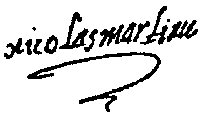
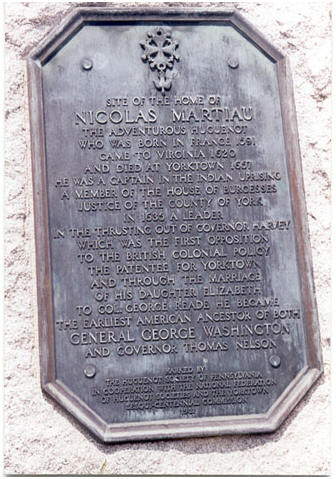 |
Belated
recognition was given the memory of Captain Nick in 1931
when a monument was dedicated in Yorktown to his
everlasting glory. The dedication address was delivered
by General John J. Pershing. The monument was designed
by the eminent Philadelphia architect, Paul Cret, and
consists of an eleven-foot shaft of Vermont granite
bearing a bronze tablet which this inscription under the
Granit Cross of the Huguenots:
SITE OF
THE HOME OF NICHOLAS MARTIAU THE ADVENTURER HUGUENOT HE
WAS BORN IN FRANCE 1591 CAME TO VIRGINIA 1620 AND DIED
AT YORKTOWN 1657. HE WAS A CAPTAIN IN THE INDIAN
UPRISING A MEMBER OF THE HOUSE OF BURGESS JUSTICE OF THE
COURT OF YORK IN1635 A LEADER IN THE THRUSTING OUT OF
GOVERNOR HARVEY WHICH WAS THE FIRST OPPOSITION IN THE
BRITISH COLONY POLICY. THE ORIGNINAL PATENTEE FOR
YORKTOWN AND THROUGH THE MARRIAGE OF HIS DAUGHTER
ELIZABETH TO COL. GEORGE READ HE BECAME THE EARLIEST
AMERICAN ANCESTOR OF BOTH GEN. GEORGE WASHINGTON AND
GOVERNOR THOMAS NELSON
Marked
by the Huguenot Society of Pennsylvania in cooperation
with the National Federation of Huguenot Societies and
the Yorktown Sesqui-centennial Commission 1931 |
 |